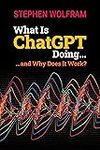
Saved by David Faulk and
What Is ChatGPT Doing ... And Why Does It Work?

Saved by David Faulk and
But this is where a bit of voodoo begins to creep in. Because for some reason—that maybe one day we’ll have a scientific-style understanding of—if we always pick the highest-ranked word, we’ll typically get a very “flat” essay, that never seems to “show any creativity” (and even sometimes repeats word for word). But if sometimes (at random) we pick
... See moreChatGPT effectively does something like this, except that (as I’ll explain) it doesn’t look at literal text; it looks for things that in a certain sense “match in meaning”.
And inside ChatGPT that’s how it’s dealing with things. It takes the text it’s got so far, and generates an embedding vector to represent it. Then its goal is to find the probabilities for different words that might occur next. And it represents its answer for this as a list of numbers that essentially give the probabilities for each of the 50,000
... See morepiggyback on something that’s already been done, or use it as some kind of proxy. And so, for example, one might use alt tags that have been provided for images on the web. Or, in a different domain, one might use closed captions that have been created for videos. Or—for language translation training—one might use parallel versions of webpages or
... See moreWhat about ChatGPT directly learning Wolfram Language? Well, yes, it could do that, and in fact it’s already started. And in the end I fully expect that something like ChatGPT will be able to operate directly in Wolfram Language, and be very powerful in doing so. It’s an
How about something like ChatGPT? Well, it has the nice feature that it can do “unsupervised learning”, making it much easier to get it examples to train from.
Because in the end what we’re dealing with is just a neural net made of “artificial neurons”, each doing the simple operation of taking a collection of numerical inputs, and then combining them with certain weights.
But how can the neural net use that feedback? The first step is just to have humans rate results from the neural net. But then another neural net model is built that attempts to predict
ultimately just dealing with data. And current neural nets—with current approaches to neural net training—specifically deal with arrays of numbers. But in the course of processing, those arrays can be completely rearranged and reshaped. And as an example, the network we used for identifying digits above starts with a 2D “image-like” array, quickly
... See more